Crucial v4 (256GB) Review
by Kristian Vättö on November 22, 2012 1:01 PM ESTAnandTech Storage Bench 2011
Last year we introduced our AnandTech Storage Bench, a suite of benchmarks that took traces of real OS/application usage and played them back in a repeatable manner. Anand assembled the traces out of frustration with the majority of what we have today in terms of SSD benchmarks.
Although the AnandTech Storage Bench tests did a good job of characterizing SSD performance, they weren't stressful enough. All of the tests performed less than 10GB of reads/writes and typically involved only 4GB of writes specifically. That's not even enough exceed the spare area on most SSDs. Most canned SSD benchmarks don't even come close to writing a single gigabyte of data, but that doesn't mean that simply writing 4GB is acceptable.
Originally we kept the benchmarks short enough that they wouldn't be a burden to run (~30 minutes) but long enough that they were representative of what a power user might do with their system. Later, however, we created what we refer to as the Mother of All SSD Benchmarks (MOASB). Rather than only writing 4GB of data to the drive, this benchmark writes 106.32GB. This represents the load you'd put on a drive after nearly two weeks of constant usage. And it takes a long time to run.
1) The MOASB, officially called AnandTech Storage Bench 2011—Heavy Workload, mainly focuses on the times when your I/O activity is the highest. There is a lot of downloading and application installing that happens during the course of this test. Our thinking was that it's during application installs, file copies, downloading, and multitasking with all of this that you can really notice performance differences between drives.
2) We tried to cover as many bases as possible with the software incorporated into this test. There's a lot of photo editing in Photoshop, HTML editing in Dreamweaver, web browsing, game playing/level loading (Starcraft II and WoW are both a part of the test), as well as general use stuff (application installing, virus scanning). We included a large amount of email downloading, document creation, and editing as well. To top it all off we even use Visual Studio 2008 to build Chromium during the test.
The test has 2,168,893 read operations and 1,783,447 write operations. The IO breakdown is as follows:
| AnandTech Storage Bench 2011—Heavy Workload IO Breakdown | ||||
| IO Size | % of Total | |||
| 4KB | 28% | |||
| 16KB | 10% | |||
| 32KB | 10% | |||
| 64KB | 4% | |||
Only 42% of all operations are sequential; the rest ranges from pseudo to fully random (with most falling in the pseudo-random category). Average queue depth is 4.625 IOs, with 59% of operations taking place in an IO queue of 1.
Many of you have asked for a better way to really characterize performance. Simply looking at IOPS doesn't really say much. As a result we're going to be presenting Storage Bench 2011 data in a slightly different way. We'll have performance represented as Average MB/s, with higher numbers being better. At the same time we'll be reporting how long the SSD was busy while running this test. These disk busy graphs will show you exactly how much time was shaved off by using a faster drive vs. a slower one during the course of this test. Finally, we will also break out performance into reads, writes, and combined. The reason we do this is to help balance out the fact that this test is unusually write intensive, which can often hide the benefits of a drive with good read performance.
There's also a new light workload for 2011. This is a far more reasonable, typical every day use case benchmark. It has lots of web browsing, photo editing (but with a greater focus on photo consumption), video playback, as well as some application installs and gaming. This test isn't nearly as write intensive as the MOASB but it's still multiple times more write intensive than what we were running last year.
We don't believe that these two benchmarks alone are enough to characterize the performance of a drive, but hopefully along with the rest of our tests they will help provide a better idea. The testbed for Storage Bench 2011 has changed as well. We're now using a Sandy Bridge platform with full 6Gbps support for these tests.
AnandTech Storage Bench 2011—Heavy Workload
We'll start out by looking at average data rate throughout our new heavy workload test:
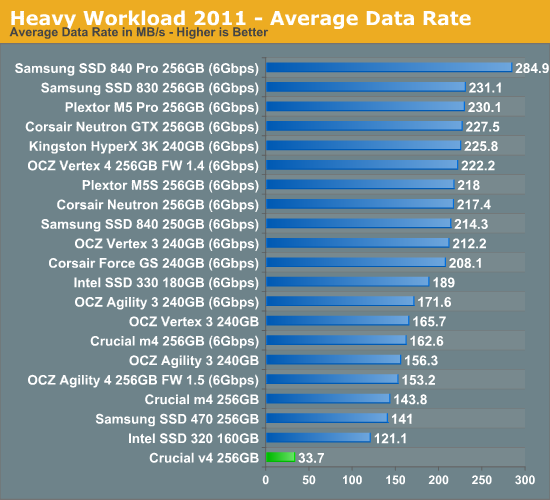
The poor random read/write speeds do have a significant impact on our Storage Suite scores as well. The v4 is the slowest SSD we have tested since the creation of the MOASB. To put this in perspective, it took over six hours for the Heavy suite to run, whereas it usually takes around an hour and a half. Any current SSD will be three to five times faster than the v4, even when operating at SATA 3Gbps speeds.
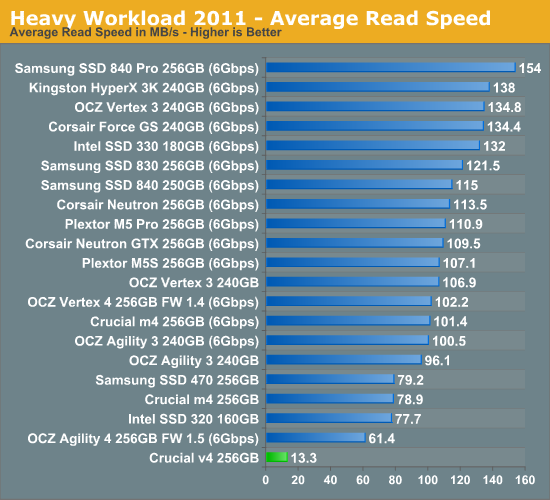
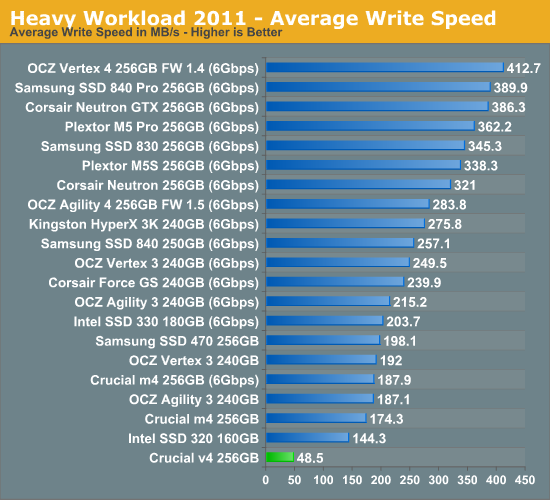
The next three charts just represent the same data, but in a different manner. Instead of looking at average data rate, we're looking at how long the disk was busy for during this entire test. Note that disk busy time excludes any and all idles; this is just how long the SSD was busy doing something:

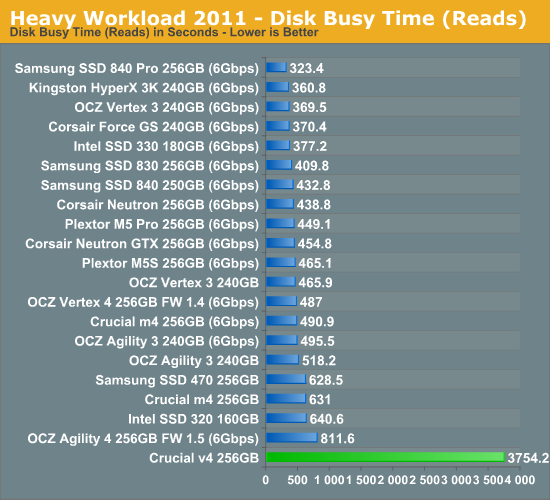
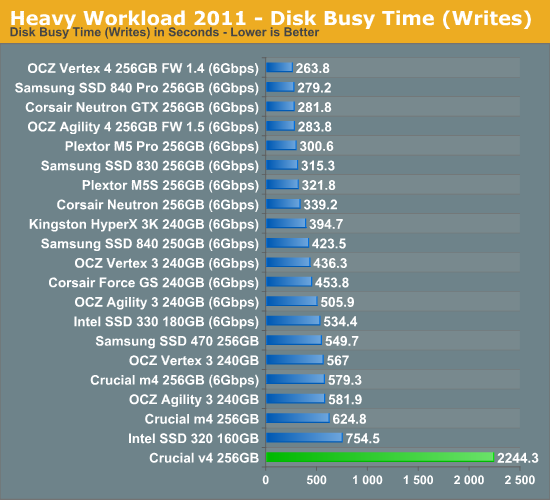










44 Comments
View All Comments
beginner99 - Thursday, November 22, 2012 - link
or 1 TB version for cheap would be available this would make sense in a laptop. But at these small capacities and the performance, it is just not recommendable. I mean my intel G2 beats it in every aspect except write.Death666Angel - Thursday, November 22, 2012 - link
Yeah, pretty much my opinion, too. I've been looking to upgrade to a new SSD for a while. The Crucial v4 is sometimes cheaper, but not by much (10-20 € compared to decent SATA 6Gb/s drives), so that it isn't really worth it to me, even if all I have at the moment are SATA 3Gb/s controllers. :)Wolfpup - Thursday, December 13, 2012 - link
Glad I saw this review, I was expecting it to be so different from the M4. Personally I'd just go for an M4. Intel's 320 series is IMO one of the best drives on the market too, but it's just too expensive versus the M4. 520 is Sandforce...kinda bug fixed Sandforce but still....WooDaddy - Thursday, November 22, 2012 - link
I'm somewhat speechless at how horrible the performance of this SSD is for a NEW product.Kristian, IF you have the time, could you add the Velociraptor to the charts or just do a side-by-side comparison? There has to be some saving grace for this drive. I know you mentioned an order of magnitude better, but considering the rest of the field is 2x - 3x better in virtually every way, maybe it's still worth it over a traditional HDD. Maybe even a comparison against a hybrid drive like the Momentus XT as well.
Kristian Vättö - Thursday, November 22, 2012 - link
600GB VelociRaptor is included in some graphs but not all since we haven't run all tests on the VelociRaptor (e.g. increasing QD doesn't affect performance, so there is no need for a separate QD32 random write test).The best tool for comparison, as always, is our Bench: http://www.anandtech.com/bench/Product/669?vs=182
jordanclock - Thursday, November 22, 2012 - link
The Bench tool is meant for just that kind of request.beginner99 - Thursday, November 22, 2012 - link
As you can see that comparison just shows how crappy hdds actually are. Even this POS is easy 10x faster in random write and 100x in random read...hnzw rui - Thursday, December 6, 2012 - link
Theoretical benches, sure. However, on the AnandTech 2010 Storage Bench, the VelociRaptor didn't perform as badly compared to an X25-M as the random 4K performance numbers would imply. I think a couple of mechanical drives (e.g. VelociRaptor and a standard 7200RPM HDD) should be benchmarked using the 2011 AnandTech Storage Bench and added to the bench tool for use as reference.Bubon - Thursday, November 22, 2012 - link
I am dissapointed. Older m4 is still better than the newer v4.Death666Angel - Thursday, November 22, 2012 - link
The newer v4 isn't meant as a replacement. That comment is like saying "my GTX 580 is still faster than the newer GT 640, damn!"....